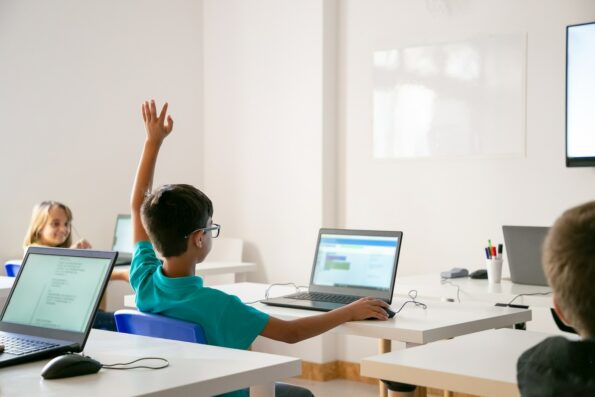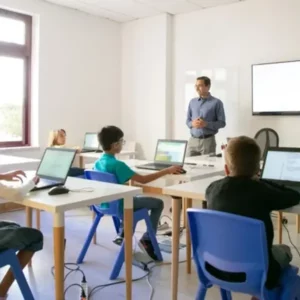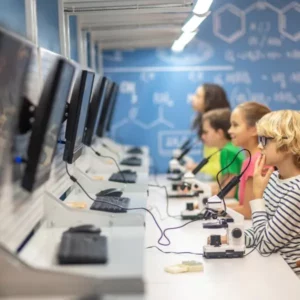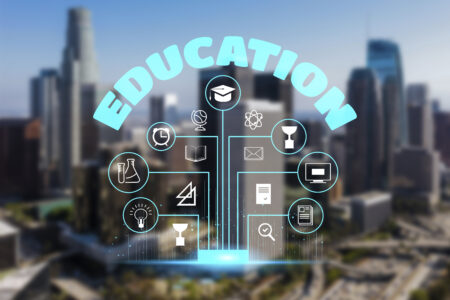Discover the transformative impact of digital classrooms in the rapidly evolving edutech landscape. This article delves into the benefits, challenges, and best practices for leveraging technology to create dynamic and effective learning environments. Navigate the exciting world of edutech and explore how digital classrooms are reshaping the future of education.

Introduction
In the era of digitalization, technology has revolutionized the way we live, work, and learn. The education sector, in particular, has seen a significant transformation with the advent of digital classrooms. In this article, we will explore the dynamic edutech landscape, focusing on how digital classrooms are reshaping traditional education models. From enhancing student engagement to optimizing teaching strategies, digital classrooms have become an integral part of the modern educational experience.
The Rise of Digital Classrooms
Digital classrooms, also known as virtual classrooms or online learning environments, have gained prominence in recent years. Enabled by technological advancements, these classrooms transcend geographical boundaries and provide learners with access to high-quality education from anywhere in the world. As a result, educators and students can connect, interact, and collaborate seamlessly, fostering a global learning community.
Benefits of Digital Classrooms
- Enhanced Accessibility: Digital classrooms have opened doors to education for learners who face geographical barriers or have specific learning needs. Students from remote areas or with physical disabilities can now access educational resources and opportunities like never before.
- Personalized Learning: Edutech platforms enable adaptive learning, where educational content and assessments are tailored to individual learning styles and progress. This personalized approach maximizes student understanding and retention.
- Flexibility and Convenience: With digital classrooms, students have the flexibility to learn at their own pace and schedule. Asynchronous learning options allow individuals to balance education with other commitments, making learning more convenient and manageable.
- Interactive and Engaging: Edutech tools facilitate interactive learning experiences through multimedia content, gamification, and virtual simulations. These engaging elements captivate students’ attention, promoting active participation and deeper understanding of concepts.
Overcoming Challenges in Digital Classrooms
- Technological Infrastructure: Ensuring robust and reliable internet connectivity is essential for seamless digital classroom experiences. Access to devices and technical support is also crucial to prevent inequalities in access.
- Digital Literacy: Students and educators must be equipped with digital literacy skills to navigate online platforms effectively. Training and support should be provided to enhance digital proficiency among all stakeholders.
- Social Interaction: In traditional classrooms, students benefit from face-to-face interactions and peer-to-peer learning. Replicating these aspects in the digital realm can be challenging, requiring innovative approaches to foster meaningful social connections.
- Data Security and Privacy: Protecting sensitive student data is of utmost importance in digital classrooms. Implementing robust security measures and adhering to data privacy regulations are vital to ensure a safe learning environment.
Best Practices for Effective Digital Classrooms
- Comprehensive Training: Educators should receive adequate training to leverage edutech tools effectively. Professional development workshops and ongoing support enable them to maximize the benefits of digital classrooms.
- Engaging Content: Incorporating multimedia elements and interactive content can elevate the learning experience. Educators should curate engaging materials that align with their teaching objectives.
- Encourage Collaboration: Foster a sense of community and collaboration among students through group projects, discussions, and virtual study groups. Collaboration enhances the social aspect of learning and encourages knowledge exchange.
- Real-Time Feedback: Digital classrooms allow for immediate feedback, enabling educators to address student queries promptly and adapt their teaching methods accordingly.
Conclusion
Digital classrooms such as smart classroom are revolutionizing education, presenting a world of possibilities for learners and educators alike. By leveraging technology to create engaging, flexible, and personalized learning experiences, the edutech landscape continues to evolve rapidly. As we navigate this transformative journey, it is crucial to address challenges, invest in digital literacy, and prioritize data security. Embracing best practices for effective digital classrooms empowers us to unlock the full potential of technology in shaping the future of education, making learning more accessible, inclusive, and impactful than ever before.










